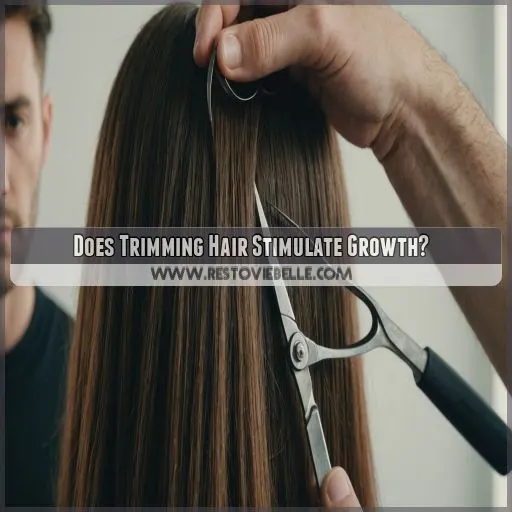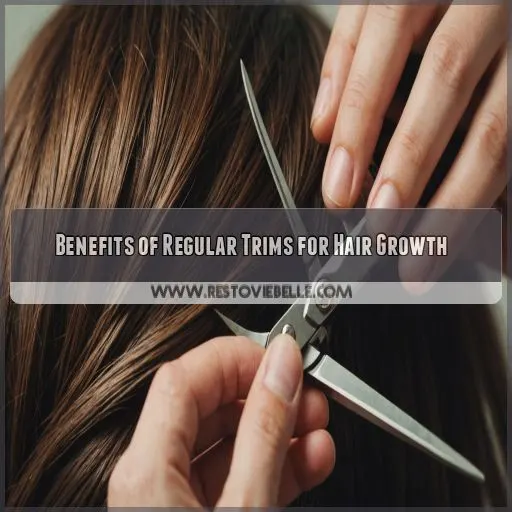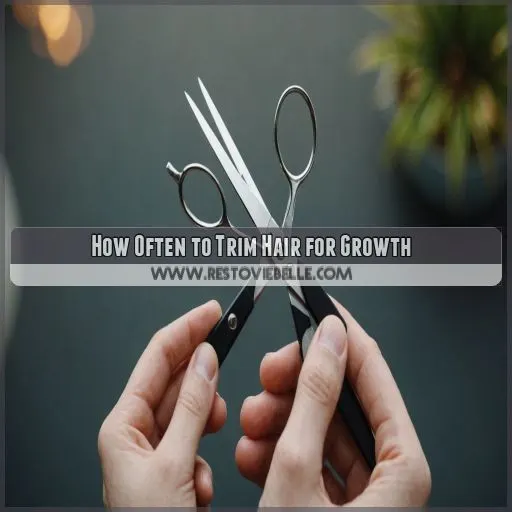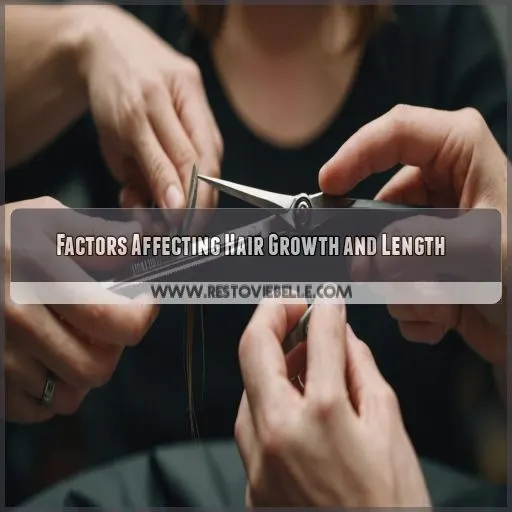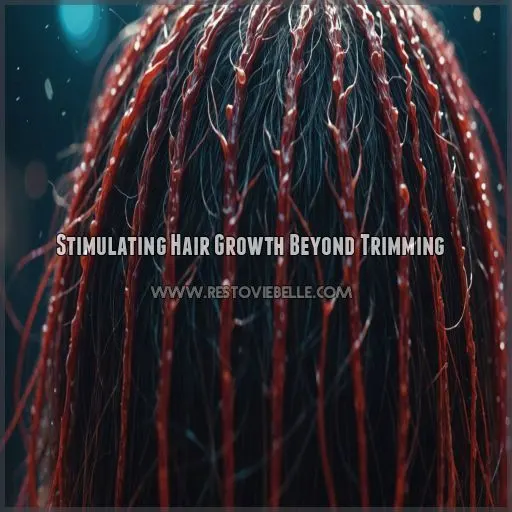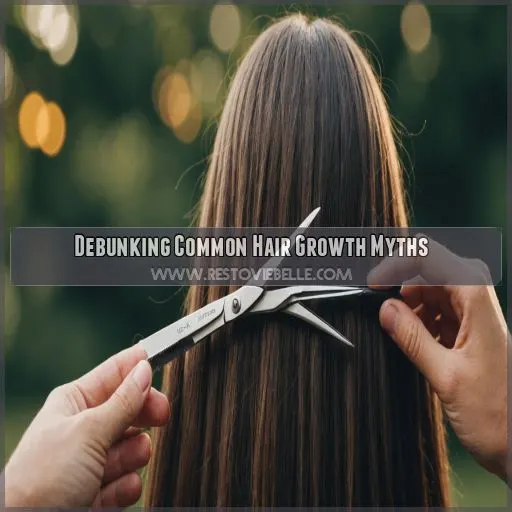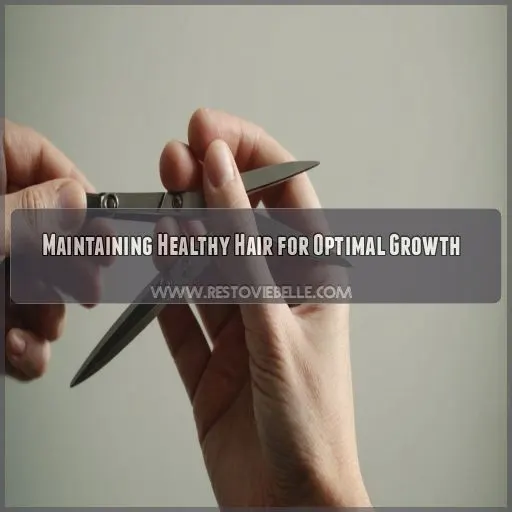This site is supported by our readers. We may earn a commission, at no cost to you, if you purchase through links.
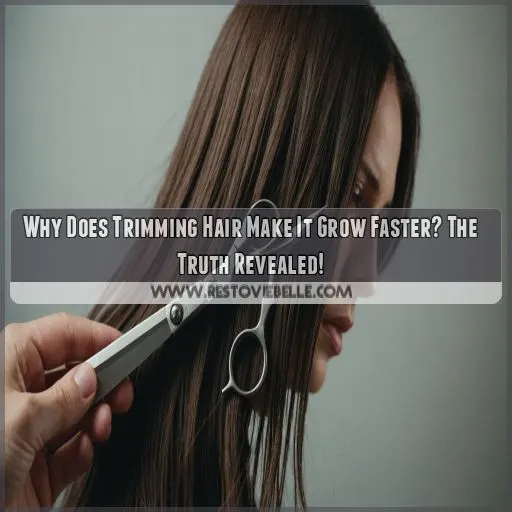
Think of trimming like pruning a plant; it doesn’t speed up growth, but it keeps those pesky split ends at bay, preventing damage from creeping up the hair shaft.
This means fewer breakages and healthier, longer-looking hair.
While cutting hair doesn’t boost the speedometer on hair growth, regular trims every 3-4 months keep your mane in excellent shape.
So, while it’s not a magical growth potion, trimming is like a cautious driver—keeping your hair journey smooth and glitch-free.
Curious about other hair growth secrets?
Table Of Contents
- Key Takeaways
- Does Trimming Hair Stimulate Growth?
- Benefits of Regular Trims for Hair Growth
- How Often to Trim Hair for Growth
- Factors Affecting Hair Growth and Length
- Stimulating Hair Growth Beyond Trimming
- Debunking Common Hair Growth Myths
- Maintaining Healthy Hair for Optimal Growth
- Frequently Asked Questions (FAQs)
- Does hair grow faster when you trim it?
- What happens if you never trim your hair?
- How often should I trim my hair when growing it out?
- Does cutting hair make it grow thicker?
- How can split ends affect hair health?
- What role do genetics play in hair health?
- Can diet impact hair thickness or shine?
- Do styling tools influence hair growth rate?
- What is the effect of stress on hair growth?
- Conclusion
Key Takeaways
- Trim your hair for health, not growth acceleration. Like a gardener pruning roses, snipping those split ends ensures your hair stays strong and healthy by preventing breakage and keeping it looking fuller and more vibrant learn how to prevent split ends.
- Hair growth magic happens at the scalp, not the ends. Your follicles are the busy bees behind the scenes driving growth, so keep your scalp happy with good nutrition and care.
- Regular trims are your best defense against troublemakers like split ends. Picture them as party crashers that can wreck your hair’s appearance. Cutting them out every 3-4 months keeps your mane in tip-top shape.
- Genetics play a big role in your hair’s growth journey. Your family tree, much like eccentric Uncle Eddie’s unexpected hair quirks, influences how soon your locks bloom or struggle to grow.
Does Trimming Hair Stimulate Growth?
You’ve probably heard that trimming your hair makes it grow faster, but that’s more myth than fact. While snipping the ends won’t speed up growth, it prevents split ends, so your hair stays healthy and retains its length without breaking.
Separating Fact From Fiction
Unraveling hair growth myths, it’s important to separate fact from fiction, like the common misconception that shaving your head makes hair grow back thicker. Trimming illusions lead many to believe hair trimming propels growth. While trimming doesn’t directly extend lengths, it cuts out split end facts, reducing breakage. Hair care truths promote healthy, strong locks instead.
The Role of Hair Follicles in Growth
You might think hair grows from the ends, but it’s the hair follicles at work in the scalp. Understanding hair growth involves:
- Follicle health impact
- Growth cycle stages
- Scalp health link
- Hair growth rate
Follicles, not trims, dictate growth.
How Trimming Affects Hair Growth
Trimming doesn’t directly make hair grow faster, but it keeps split ends at bay. Picture your hair as a garden; trimming‘s like pruning. It keeps strands strong and healthy, preventing breakage. So, consult your stylist regularly for the best possible hair health!
Benefits of Regular Trims for Hair Growth
Regular trims are the secret weapon for hair growth. By preventing split ends and promoting stronger, healthier strands, routine trims can help you achieve your long hair goals. (Source)
Preventing Split Ends and Breakage
In your hair care routine, split ends are like party crashers. Regular trims tackle these intruders, preventing breakage. Here’s why:
- Reduces damage avoid further split ends by preventing further split ends from traveling up the hair shaft.
- Enhances appearance Achieve healthier hair.
- Strengthens strands Maintain good health.
Promoting Stronger Strands and Healthier Hair
Healthy hair depends on scalp health and a balanced hair care routine. Regular trims can transform damaged hair into stronger strands by snipping away frayed ends. Include nourishing hair products and vitamins—your hair will thank you, and you’ll love the results!
Achieving Longer Hair Goals
While promoting stronger strands is key, trimming your hair helps achieve longer hair goals by stopping split ends from wreaking havoc. It’s like cutting off a bad romance—sure, it hurts a little, but you’ll grow healthier and more fabulous.
How Often to Trim Hair for Growth
If you want your hair to look its best, knowing when to trim it’s as important as choosing the right shampoo. While trimming won’t make it grow overnight, it does keep split ends in check, helping your hair appear longer and healthier over time.
Recommended Trim Frequency for Healthy Hair
Think of trimming as tidying a garden. For healthy hair, schedule trims every three to four months. This trim frequency suits most hair types and helps prevent split ends. Skipping trims can lead to damaged hair, impacting your hair’s growth phases.
Trim Cycles for Maintaining Length and Strength
You’ve learned about trim frequency benefits, but how often should you trim for strength? Let’s cut to the chase:
- Trim every 6-8 weeks to manage split ends.
- Thank breakage prevention for healthier hair.
- Secure your hair goals effortlessly.
Adjusting Trim Frequency Based on Hair Type
Your hair type determines the ideal trim frequency. Fine hair may need trims every 4-6 weeks, while thick or curly hair can wait 3-4 months. Damaged strands call for more frequent visits, while straight hair can go longer between cuts.
Factors Affecting Hair Growth and Length
You might think trimming your hair makes it grow faster, but the truth is, hair growth is all about what’s happening on your scalp, not at the ends. Genetics, nutrients, and even a quirky little gene called FGF5 play starring roles in determining how long and strong your hair gets.
The Impact of Genetics on Hair Growth
Trimming aids in managing split ends, but did you know your genetic predisposition holds the reins on hair growth rates? Just like Uncle Bob’s quirky eyebrows, your family’s history shapes your hair’s journey, impacting ethnic differences and tendencies for thinning.
Nutrients and Vitamins for Hair Health
Genetics affect your hair, but nutrients and vitamins are your secret power-up! Avoid diet deficiencies to keep those strands strong.
- Biotin: Promotes hair strength and growth.
- Hair Vitamins: Support overall hair health.
- Iron Deficiency: Can lead to hair loss.
- Balanced Diet: Essential for luscious locks.
The Role of the FGF5 Gene in Hair Growth
The fgf5 gene plays a pivotal role in your hair growth cycle. By blocking this gene, you can extend the growth phase and promote lush, healthy locks. Explore FGF5 inhibitors to take control of your genetic hair growth potential.
Stimulating Hair Growth Beyond Trimming
While trimming won’t make your hair grow directly, making it look and feel great is half the battle. By switching to the right shampoo and giving yourself scalp massages, you’ll feed your hair with the nutrients it needs to shine and thrive.
Using Shampoo and Conditioner for Hair Type
Choosing the right shampoo and conditioner for your hair type is like finding Cinderella’s slipper. Match product ingredients to your needs:
- Strengthen your scalp health
- Support healthy hair growth cycles
- Control excess oil or dryness
- Enhance shine and manageability
Massaging the Scalp for Improved Blood Flow
After choosing the right shampoo and conditioner, embrace DIY scalp massage. Using scalp massage tools or your fingers, gently massage your scalp. This boosts blood flow, fostering hair growth. Imagine your hair follicles doing a happy dance! Aim for regular massage frequency.
Choosing Products for Hair Strength and Support
For stimulating hair growth, the right products can make all the difference. Look for shampoos, conditioners, and treatments packed with strengthening ingredients like keratin, protein, and vitamins to nourish your locks from root to tip.
Debunking Common Hair Growth Myths
You’ve probably heard the myth that trimming your hair makes it grow faster, but is it true? Let’s cut to the chase and untangle these common misconceptions together!
Does Cutting Hair Make It Grow Thicker?
Sure, massaging your scalp supercharges growth. But if you think chopping your locks instantly thickens them, let’s hit the brakes—that’s a myth! Trimming just removes unsightly split ends, making hair seem thicker. True thickness? It’s all about scalp health and genetics.
What Happens if You Never Trim Your Hair?
Unkempt hair without trims is like a garden overrun with weeds. Split ends, hair breakage, and a tangled mess create a frizzy hair disaster. You’ll face an unhealthy appearance, leaving you tangled in a web of unruly locks.
Separating Fact From Fiction in Hair Growth
Sorting fact from fiction is key when it comes to hair growth. Forget the myths – let’s get into the real science behind healthy hair and what actually stimulates growth. Spoiler alert: Trimming alone won’t make your locks sprout faster!
Maintaining Healthy Hair for Optimal Growth
Maintaining healthy hair for good growth isn’t just about skipping a cut; it’s about giving your hair the best environment to flourish, much like a plant thrives with regular care. Just as a gardener wouldn’t skip watering their plants, don’t skip trimsthey’re the secret to luscious, breakage-free locks!
The Importance of Regular Trims and Maintenance
- Regular trims combat split ends, boosting hair health.
- Form an unbeatable hair care routine.
- Trim frequency matters—maintain those tresses like a pro!
Protecting Hair From Damage and Breakage
Protecting your hair from damage and breakage is like a knight guarding a castle—essential for growth. Limit heat styling and over-zealous hair brushing.
| Avoid | Be Cautious With | Support |
|---|---|---|
| Chemical damage | Color treatment | Scalp health |
| Over-brushing | Heat styling | Hair care routines |
Achieving and Maintaining Healthy Hair for Growth
Curious how to achieve luscious locks? The secret lies in a holistic hair care routine. Nourish your scalp, fuel your strands with the right nutrients, and handle your hair with care – your growth goals are within reach!
Frequently Asked Questions (FAQs)
Does hair grow faster when you trim it?
Ironically, trimming your hair doesn’t make it grow faster. Growth depends on the scalp, not the ends. However, by chopping off those pesky split ends, your hair stays healthier and stronger, cleverly preventing breakage while you master lush locks.
What happens if you never trim your hair?
If you never trim your hair, those pesky split ends will just keep creeping up, making your locks look scraggly and fried. Regular trims keep your hair healthy and strong, so it can grow longer and stronger over time.
How often should I trim my hair when growing it out?
To grow long, luscious locks, trim your hair every three to four months. This prevents split ends from spreading, keeps your mane strong, and you won’t chop off more length than necessary when you do visit the salon.
Does cutting hair make it grow thicker?
Imagine a gardener pruning a rose bush to help it flourish. Similarly, trimming your hair doesn’t make it thicker but removes split ends, preventing further breakage and giving the appearance of fuller, healthier strands.
How can split ends affect hair health?
Split ends are like tiny rebels on a mission to cause mayhem up your hair shaft. They weaken strands, leading to breakage and messy, unhealthy-looking hair, making it harder to maintain length and health. Trim them away!
What role do genetics play in hair health?
Your genes play a huge role in how fast and long your hair grows, but optimize beard growth can help you maximize your potential. Some folks are just blessed with hair that sprouts like weeds, while others have to work a bit harder to achieve their luscious locks.
Can diet impact hair thickness or shine?
A balanced diet can do wonders for your hair! Think of it like giving your locks a spa treatment from inside out. Nutrient-rich foods boost thickness and shine; your hair will thank you with brilliance!
Do styling tools influence hair growth rate?
Styling tools don’t directly change your hair’s growth rate, but overuse can cause damage and breakage, making growing hair longer challenging. Beard Care and Maintenance can help you keep your beard healthy and strong. To reduce harm, always use a heat protectant and avoid high temperatures (Source).
What is the effect of stress on hair growth?
Stress can stunt hair growth, pushing hair follicles into rest mode like a snooze button on a lazy morning. Managing stress levels is key to keeping your hair cycle moving along faster and healthier. (Source).
Conclusion
Imagine this: your hair, a lush garden flourishing with each careful trim.
While trimming may not directly accelerate growth, it’s the gardener’s secret to nurturing healthy, vibrant locks.
By snipping away split ends and damage, you create the best conditions for your hair to thrive.

